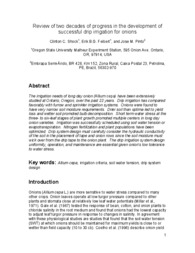Review of two decades of progress in the development of successful drip irrigation for onions.
Review of two decades of progress in the development of successful drip irrigation for onions.
Author(s): SHOCK, C. C.; FEIBERT, E. B. G.; PINTO, J. M.
Summary: The irrigation needs of long day onion (Allium cepa) have been extensively studied at Ontario, Oregon, over the past 22 years. Drip irrigation has compared favorably with furrow and sprinkler irrigation systems. Onions were found to have very narrow soil moisture requirements. Drier soil than optima led to yield loss and wetter soil promoted bulb decomposition. Short term water stress at the three- to six-leaf stages of plant growth promoted multiple centers in long day onion varieties. Irrigation was successfully scheduled using soil water tension or evapotranspiration. Nitrogen fertilization and plant populations have been optimized. Drip system design must carefully consider the hydraulic conductivity of the soil in the placement of tape and onion rows since the soil moisture must wick over from the drip tape to the onion plant. The drip irrigation system design uniformity, operation, and maintenance are essential given onion?s low tolerance to water stress.
Publication year: 2013
Types of publication: Paper in annals and proceedings
Unit: Embrapa Semi-arid Region
Keywords: Allium Cepa, Cebola, Estresse hídrico, Irrigação por Gotejamento, Onion
Observation
Some of Embrapa's publications are published as ePub files. To read them, use or download one of the following free software options to your computer or mobile device. Android: Google Play Books; IOS: iBooks; Windows and Linux: Calibre.
Access other publications
Access the Agricultural Research Database (BDPA) to consult Embrapa's full library collection and records.
Visit Embrapa Bookstore to purchase books and other publications sold by Embrapa.

